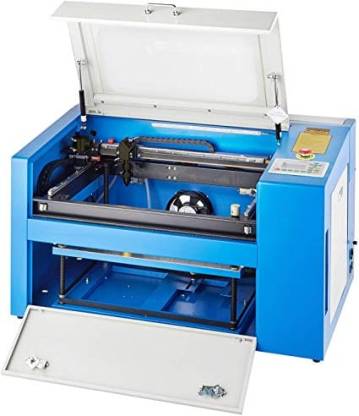Why Would You Use A Laser Cutter: Laser cutting is an alternative energy source that is used in several areas Understand some benefits and disadvantages of laser cutting by orienting yourself in device technical details Laser cutters generate designs and patterns by cutting them into materials as the name indicates. The force that melts burns or vaporizes the substance is a powerful Laser Beam.
Why Would You Use A Laser Cutter
Laser cutting is a technique used to slice materials using a laser. Although usually used for industrial manufacturing applications, colleges, small businesses, and software developers are also beginning to use it.
Laser cutting operates most effectively by lasers by controlling the performance of a heavy-power laser. The product laser for cutting components actively engaged a gesture recognition system that would follow a pattern CNC or G-code to be reduced to the material.
How Laser Cutting Works
The beam of a laser cutter is usually between 0.1 and 0.3 mm in diameter and between 1 and 3 kW in strength. That control needs to be changed, depending on the material getting cut as well as the density. For example, you may need laser power of up to 6 kW to cut reflective metals such as aluminium.
Laser cutting is not ideal for materials like iron and metal oxides since they have superior temperature-conductive and sun-reflective characteristics, which means they require considerable lasers.
The Laser Resonator: The beam of light appears to come from a laser transducer, an impermeable tube of glass with two mirrors facing in every direction. The pipeline is made of C02 and other gases such as helium, potassium, and hydrogen. The mixture of these gasses is caused by diodes or an electromagnetic emission in the form of electricity-emitting light.
The Cutting Head: The light travels in multiple directions with the majority of numerous lens help, which is perfectly positioned to ensure that the laser cutting head hits it. After entering the cutting head, the beam passes through some circular lens and is amplified and focused on a specific point.
 The laser is transformed into a small, focused beam within this cutting head, which can be sliced or restored. Upon reaching the target, the directed laser beam passes through a nozzle, with natural gas such as oxygen or helium also moving through another tube.
The laser is transformed into a small, focused beam within this cutting head, which can be sliced or restored. Upon reaching the target, the directed laser beam passes through a nozzle, with natural gas such as oxygen or helium also moving through another tube.
When you break iron or aluminium, for example, the beam laser melts the steel before the overheated steam explodes the soft metal out of the distance. The cutting head is usually connected to a motor device operated by a chain or belt that allows precise moving inside a specific range. The lens focal point has to be on the surface of the product being sliced to make an actual cut for the laser.
Advantages and Disadvantages:
Advantages: Certain methods, such as CNC milling, can produce different effects to such a laser blade/fabricator, so here we mention what we find to be the advantages of laser cutting over specific methods.
- A high fidelity that it offers helps to react more clear images negatively and to allow better cuts.
- The level of output is stronger.
- A broad range of products is cuttable without damaging them.
- Compared with CNC machines, it is a more attractive option.
- It is familiar with any AutoCAD or Adobe Illustrator vector program.
- This does not produce scrap like wood chips.
- With the right equipment, it is very simple to use.
Disadvantages: So as almost this can be perfect, here are the drawbacks that we considered.
- Heavier substances are harder to cut or need very low velocities.
- Products with higher densities such as glass cannot be cut.
- This burns whatever object you want to cut to the bottom.
- Some materials can produce toxic emissions, such as plastic.
- Based on the material thickness and density, processing rates aren’t always consistent.
- These laser cutters use a lot of power, which increases the cost of production.
Three huge Laser Cutting Varieties:
Flame/Reactive Rutting: The assist gas is oxygen under high pressure that is mostly pushed through the range. A hot substance responds with oxygen and starts burning and oxidizing. The reaction brings out more energy and strengthens the laser light.
Check: https://emitlaser.com/product-category/laser-cutter/
Fusion Cutting/Melt and Blow: However, the artificial natural gas distributes solid or liquid content out of width, significantly reducing the power needed. The substance is heated up first until it approaches its surface temperature then it is blown out by air.
Remote Cutting: The material is partly evaporated by a high-intensity laser beam, which allows cutting thin sheets without the need for support steam.
Conclusion:
Laser cutting is a groundbreaking innovation that has proved its usefulness more than ever. Best of all, these days it is open to all, through either business services or personal computers.
But, as can be seen, the technology is not yet complete, with some problems that need to be resolved before other related technologies such as CNC routers can be regarded as better. Every year, with improved cutting abilities, more efficient and specific machines are built, and we expect many of these inconveniences to be mitigated in the coming years.
HussaiN is a full-time professional blogger from India. He is passionate about content writing, tech enthusiasts, and computer technologies. Apart from content writing on the internet, he likes reading various tech magazines and several other blogs on the internet. Email ID: arrowtricks.pvt@gmail.com


0 Comments